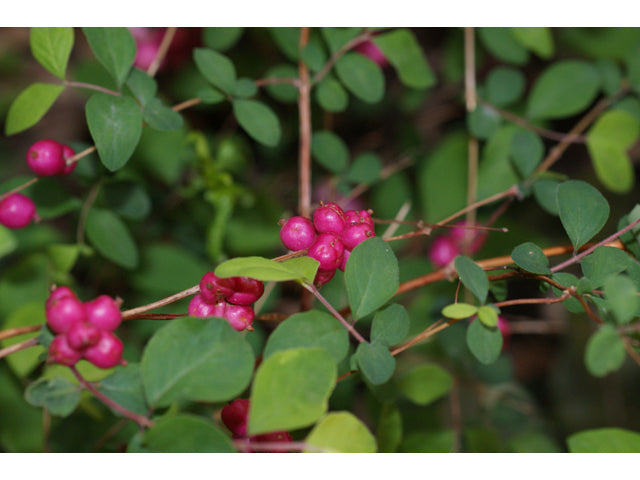Coralberry (Symphoricarpos orbiculatus)
Coralberry (Symphoricarpos orbiculatus)
Low stock: 5 left
Couldn't load pickup availability
Symphoricarpos orbiculatus
Symphoricarpos orbiculatus Moench
Coralberry, Indian Currant, Buckbrush
Caprifoliaceae (Honeysuckle Family)
Synonym(s): Symphoricarpos symphoricarpos
USDA Symbol: SYOR
USDA Native Status: L48 (N), CAN (I)
This small, mound-shaped, deciduous shrub with shredding bark on older wood and brown to purplish branchlets covered with short hairs visible under a 10x hand lens, usually grows to 4 ft. but can reach 6 ft. Its smooth, dull green leaves are opposite and roughly oval, tapering about equally to tip and base, up to 2 inches long but often less than 1 inch, with smooth, turned down margins and a rounded or broadly pointed tip. The greenish-white flower clusters are not as showy as the clusters of coral-pink to purple fruit up to 1/4 inch in diameter which remain on the plant through winter.
Particularly common in Post Oak (Quercus stellata) woods, Coralberry forms extensive colonies and spreads by rooting at the nodes where it touches the ground. A good choice for a woodland garden.
Plant Characteristics
Habit: Shrub
Leaf Retention: Deciduous
Leaf Arrangement: Opposite
Leaf Complexity: Simple
Fruit Type: Drupe
Size Notes: Up to about 6 feet tall.
Fruit: Purple, pinkish purple, coral pink, 1/8 inch.
Bloom Time: Apr , May , Jun , Jul
Distribution
USA: AL , AR , CT , DC , DE , FL , GA , IA , IL , IN , KS , KY , LA , MA , MD , MI , MN , MO , MS , NC , NE , NJ , NY , OH , OK , PA , RI , SC , SD , TN , TX , UT , VA , VT , WI , WV
Native Distribution: Eastern US from New York south to eastern Texas, west to South Dakota and Colorado.
Native Habitat: Shaded woods, thickets, open woodlands, streambanks, river banks. Common in Post Oak woodlands (Quercus stellata).
Growing Conditions
Water Use: Low , MediumLight Requirement: Part Shade , Shade
Soil Moisture: Dry , Moist
Soil pH: Circumneutral (pH 6.8-7.2)
CaCO3 Tolerance: Low
Soil Description: Well-drained sand, loam, or clay.
Benefit
Use Ornamental: A low-growing forest shrub with attractive winter berries and persistent, bright green foliage for use in eastern North America.Use Wildlife: Songbirds, ground birds, small mammals, and browsers use this plant for food, cover, and nesting sites.
Interesting Foliage: yes
Attracts: Birds
Deer Resistant: Moderate
Value to Beneficial Insects
Special Value to Native BeesSupports Conservation Biological Control
This information was provided by the Pollinator Program at The Xerces Society for Invertebrate Conservation.
https://www.wildflower.org/plants/result.php?id_plant=SYOR
Image Information
Photographer: Mathews, RayCity: Austin
County: Travis
State: TX
Location Notes: Lady Bird Johnson Wildflower Center. Observation Tower Garden.
Accession date: 2014-06-04
Filename: RCM_IMG0473.JPG
Slide Index: Coralberry - Best Wildflowers Spring 2013 DSC06558
Restrictions: Unrestricted
Collection: Wildflower Center Digital Library
Original Format: Digital
Orientation: Landscape
Shot: Branches with leaves and clusters of mature magenta-colored fruits (drupes).
Date Taken: 2/26/2013
NPIN Image Id: 37505


